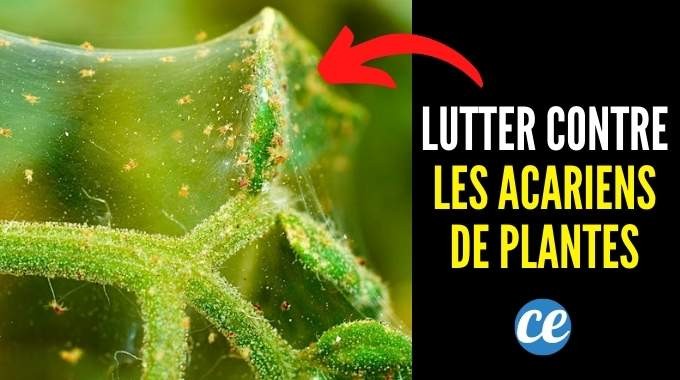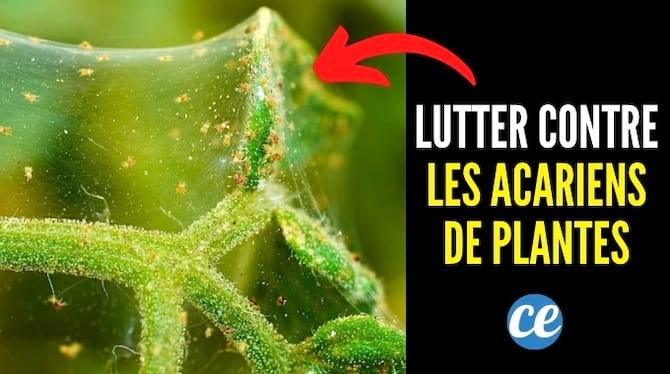
Today I show you how to get rid of plant mites with natural treatments.
You do not know what it is ? Logically, these mites are invisible to the naked eye!
On the other hand, I can tell you that their presence is a real disaster for the plants.
These mites dry out the plant and can even kill it.
Then, if these pests are installed, it's the cross and the banner to get rid of them...
And I know what I'm talking about, I've paid the price several times in my garden.
But luckily, thanks to well-placed grandmother's natural recipes, I managed to eradicate the problem.
Here are 7 tips to get rid of plant mites naturally. Watch:

Cousins of ticks, spiders and even scorpions, plant mites are not insects.
They are arachnids the size of a single grain of sugar!
These 8-legged oval critters are therefore very difficult to spot without the aid of a microscope or magnifying glass.
These plant mites come in several varieties.
There is the so-called southern red spider mite, the carmine spider, the strawberry or spruce spider.
But the most common is the so-called "2-point" one.
Yellow/orange in color with a dark spot on both sides of the body, these mites live in colonies.
They cling to the underside of leaves and feed on the plant's chlorophyll.
Plant mites are not dangerous to humans, but can be deadly to plants.
Despite their short life cycle (3 to 4 weeks), they reproduce very quickly.
Barely 5 days old, the female begins to lay eggs which take only 72 hours to hatch.
These mites are very active in hot and dry environments, especially in summer.
They move from one plant to another, or from outdoors to indoors, clinging to people.
The telltale signs of an infestation are quite characteristic:
- There may be white or yellow spots on the leaves.
- The appearance of webs on plants.
- Or leaves falling for no reason.
Beware, other parasites can produce similar problems.
So before planning disinfection actions, make sure you are dealing with plant mites.
Yes, but how are you going to tell me? Well I'll give you a little technique that my grandmother used.
Hold a paper plate or a sheet of white paper under the leaves where you suspect an infection.
Tap on the leaves of the plant.
If mites are present, small specks fall off and appear on the paper as they move.
So much for the presentation of the main plant mite.
But before giving you the tricks to eradicate them, let's first look at how to keep them at bay.
Before resorting to drastic measures, know that it is quite possible to keep these critters at a distance.
This requires following a few simple basic principles:
- Do not place your indoor plants near a heat source (radiator for example). These beasts like hot and dry places above 20°.
- Do not spread insecticides on your plants. By doing this, you kill the natural predators of mites which increases their proliferation!
- Water your plants regularly. These mites do not like humidity at all.
- Do not place your plants near open windows or air vents. Dust mites can enter from the outside.
- Wipe plant leaves with a damp cloth every week.
- Plant plenty of dill or cilantro near your plants to keep mites at bay.
If, despite our advice, mites have still appeared, then use these natural solutions.

Lacewings, thrips, lady beetles and phytoseiulus persimilis are the natural predators of plant mites.
To encourage the presence of these insects in the area, simply avoid using pesticides.
Mulch flower and garden beds and water regularly.
For your indoor plants, there is a more radical solution.
You can buy live predatory mites or insects online!
Drop them in the jars and they'll take care of the rest.
They can consume hundreds of plant mites per day and pose no danger to your plants.
Nor for you or your pets for that matter.
A 2017 study found that certain essential oils are very effective against 2-spot mites.
This is the case with chamomile, coriander, spearmint and rosemary essential oils.
Fill a spray bottle with water and 4/5 drops of the oil of your choice.
Then spray the solution on the affected leaves and... bye bye eggs and adults.
Know that neem oil is also effective; it has the particularity of suffocating those pesky dust mites.
Some varieties of peppers (jalapenos, cayenne peppers) are toxic to plant mites.
In fact, tests performed with these peppers have determined that they kill at least 45% of adult mites.
Other varieties of peppers, such as "Lemon drop" peppers or "Bishop's Crown" peppers also repel these mites.
The recommended method is as follows.
Mix 2 teaspoons of chilli powder in a bowl with a little cooking oil.
Let stand overnight.
The next day, add 1 to 2 teaspoons of black soap. This emulsifies everything.
Finally add 1/2 liter of barely lukewarm water (rainwater can be used) and mix.
Above all, put on a mask and gloves before spraying the solution on your plants.
Academics have shown that a dish soap solution kills dust mites .
That said, no need for major studies to find out. Most gardeners know this trick!
Mix 3 tablespoons of dishwashing liquid with 4 liters of water.
Spray the solution directly on the leaves of the infested plants and leave to act for 2/3 hours.
If necessary, do not hesitate to repeat this every week until the disappearance of the mites.
You certainly have 90° alcohol in your cupboards.
Good if so, because this product helps you get rid of plant mites.
Dip cotton balls in 90° alcohol and wipe the foliage of infested houseplants with it.
Leave for 2/3 hours then rinse the leaves thoroughly with water.
Be aware that watering the plants with a garden hose helps eliminate mites.
Under pressure, the clever little ones who would have escaped the methods seen above fall one by one.
The problem is that they can come back after each rinse... so watering is only a temporary solution.
Diatomaceous earth, derived from fossils of aquatic organisms, is a deadly natural insecticide!
Arachnids and insects are not resistant to it, while this product is completely harmless to humans.
Sprinkle food-grade diatomaceous earth over infested plants and soil.
This dehydrates the exoskeletons (aka the covering that protects the mite) of plant mites and kills them.
Garlic is not only used to spice up your dishes.
Its dissuasive smell also serves to repel insects and our famous dust mites.
All you need to do is create a small homemade decoction.
Take a blender, put a bunch of mint and about ten cloves of garlic in it.
Half fill with water and mix everything.
Once the preparation has become liquid, pour it into a saucepan and heat for 1 minute over medium heat.
Add 1 tablespoon cayenne pepper powder and boil.
Let your mixture sit overnight and in the morning add liquid natural soap.
All you have to do is pass the mixture through a funnel and pour it into the tank of the vaporizer.
Spray the solution on the infected plants, it's radical!
Now that you know how to get rid of plant mites, let's finish with some more tips.
Using the predatory insect method, the mite problem usually resolves within a few days.
Indeed, these insects can devour hundreds of mites a day!
For other treatments, apply them weekly until the problem is resolved.
If the infestation is not severe, it takes at least 2-3 weeks to completely get rid of the mites.
Plant mites feed on the tissues of hundreds of plant varieties.
They especially like outdoor plants like melons, strawberries, tomatoes and fruit trees.
Indoor plants, like decorative flowers, are not spared, however.
If despite the solutions seen above, the mites get out of control, throw the plant in the trash.
Be careful to close the bag tightly so that they do not escape!
Because as I have already told you, mites jump from plant to plant and even on you.